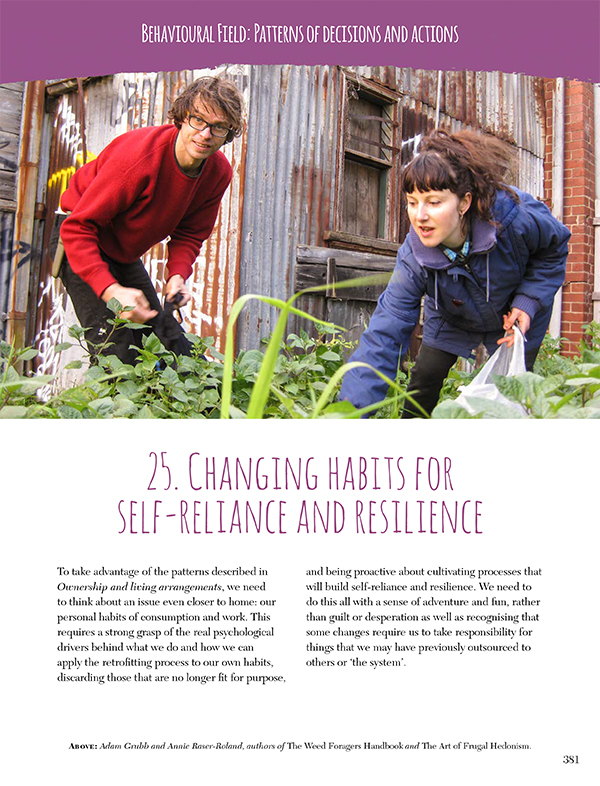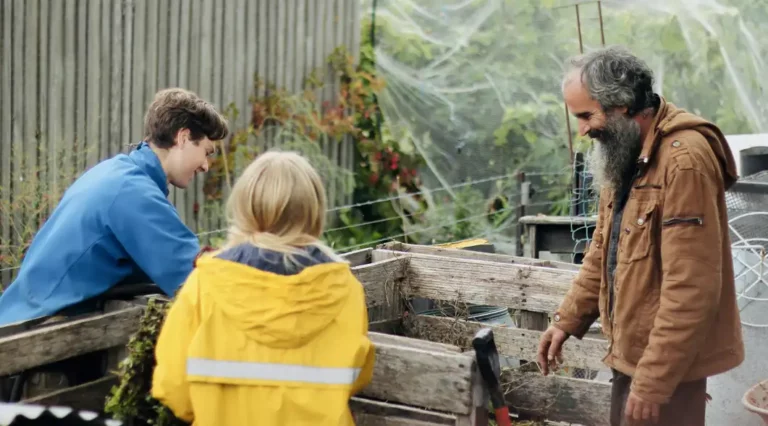about the book
Part A: Setting The Scene
The first section of RetroSuburbia: the downshifter’s guide to a resilient future explores the big-picture issues, concepts and thinking tools that I think are useful in creative household level responses to the challenges of the coming years and decades.

Key challenges and retrosuburban responses outlines the connections between the personal and global challenges of the near future and how suburbia might a good place to survive and thrive in challenging futures. It also introduces some of the thinking tools, such as permaculture and pattern languages, to help retrofit suburbia one household at a time.
This conceptual content is balanced by an engaging short story about the history and future of Aussie St, my imaginary suburban street that resonates with the lived experience of so many Australians. It moves from the experience of the oldest living Australians though to a gritty but empowering vision of the near future.
Where we live and how we live introduces tools to help us explore and evaluate how we live now – and how we might make lifestyle changes into the future. It discusses overarching life patterns such as the work/life balance and the pros and cons of lifestyle choices such as owning, living communally, downshifting and/or retaining flexibility.
Part B. Built Field: Patterns of Human Habitats
The Built Field covers the recurring patterns and design solutions relevant to retrofitting detached houses and the other physical systems that support suburban households. This is an obvious starting point for many who want to make their place a better longterm prospect.
Retrofitting is less costly than new construction, allowing permaculture downshifters to focus on food production, water systems, home-based livelihoods and community resilience rather than sinking all their efforts into state of the art eco-housing.

The first chapter, How to assess a property, aims to help you evaluate an exciting property, whether it is the one you are already living in or one you are considering moving to. It is arranged as a series of questions to guide you through the assessment process, and a simplified checklist of these items is available to help you assess all these factors and patterns.
Warm in winter, cool in summer tackles the issue of thermal comfort with ideas for keeping the people in your household cosy. This leads naturally into Wood energy with options not only for heating indoor spaces, but also for cooking and hot water.
Electricity is a touchy topic with many in society regarding it as an essential service rather than a high quality energy source that should be used for specific functions. In this chapter I explore this idea and provide some thoughts on household electricity generation, as well as some substitutions to allow households to reduce their consumption.
The ability to undertake Water harvesting and storage is critical to household resilience, but I also cover the pros and cons of using mains water. In the garden, this can be supplemented with household wastewater, with human waste supplying further nutrients through composting toilets: these topics are covered in Greywater and human nutrient recycling.
A self-reliant household eating a local diet with a lot of home grown produce will need good Facilities for food: storage, preparation and cooking spaces. Retrofitting for bushfire defence looks at the practical, physical things we can do to our buildings and surrounds to make them more resilient to bushfire threats, whilst Storage of stuff tackles the issue of prioritising, organising and storing all the equipment, tools and other objects we might need for a self-reliant household.
Retrofitting for shared living discusses infrastructure and changes to physical spaces that could assist you to increase household size and density whilst still maintaining privacy.
The Built Field covers many general patterns that might be useful for your living space, but it does not provide specific details. For example, I don’t tell you how to install a safe and legal flue pipe for a wood stove however the patterns I outline should help you review and decide on the best options for wood heat and/or cooking to make your place more comfortable, affordable, productive and resilient in the future.
Part C. Biological Field: Patterns of life and growth
The possibilities for retrofitting the Biological Field are many and varied. Every residential block has soil with a history of use and/or abuse, established plantings, some of which may produce food, and a wider ecological context of sunshine, water, wind, vegetation and wildlife that influence the site.

Part C introduces recurring patterns and proven design solutions for abundant garden farming in suburbia. It doesn’t tell you how to raise seedlings or graft a tree but it will help you select and design the best growing systems for vegetables and fruit trees, along with guidelines on what to grow to make best use of what space you have without moving to a rural property.
Like the first chapter in the Built Field, the Biological Field starts with a series of questions that should enable you to assess the potential for growing and utilising living things on your site: How to assess a garden.
Garden farming explores the different methods that are used to grow food in garden spaces, how you might optimise the available space and the amount of food that might be produced.
The basis of plant, animal and human health is good, well-mineralised soil; Building and maintaining soil fertility covers practical strategies for improving soil at a suburban scale. Managing soil contamination discusses a common issue – that of unwanted chemicals in the soil and some strategies for dealing with them.
Some suggestions on what plants to prioritise in garden farming systems are given in What to grow where and Food growing systems looks in more detail at tried and tested systems for growing vegetables and fruit in small spaces. How these plants might be propagated and distributed is discussed in Seed saving and backyard nursery.
Animals and plants have synergistic relationships in functioning ecosystems, including backyard ones. In Domestic animals in suburbia I discuss domesticated animals that are useful at a suburban scale and in Wildlife in the garden; by and beyond design I extend this discussion out to cover non-domesticated animals, including pest species that may be problematic.
Finally, in Beyond the boundaries we move out from the household garden into larger public and private spaces where different techniques are more suitable.
Part D. Behaviour Field: Patterns of decisions and actions

The Behavioural Field includes everything about how we live in the Built and Biological Fields, from our most unconscious actions through to complex collective organisation that extends from the household out into the wider community and economy.
This section begins with a chapter outlining the Ownership and living arrangements that you could consider before embarking on a retrosuburban journey – my survey of the options covers a rapidly evolving territory of creative solutions! Next we dive into the touchy task of looking at the habits and roles that may be blocking you from finding and following your downshifting path: Changing habits for self-reliance and resilience. Behaviour changes are often critical to avoid some of the perennial issues in our Transport and travel.
Creating your own livelihood in a downsizing world is especially important for younger people planning for the future. And for older people aware of the pointers to uncertain futures, working out what to do with savings and assets often ends up in the too-hard basket, allowing the default usual suspects to determine what happens to our money; the Financial planning and security chapter offers some alternative suggestions. There are no easy answers in either aspect of financing our choices but I provide a review of the options and the pros and cons.
The Sustaining and sustainable diet chapter gets back to basics about aligning our habits and desires with foraged and farmed abundance of season and place. Food and raising children can be one of the make or break issues for most households, thus food naturally segues to Rearing self-reliant and resilient children. As if it couldn’t get any more personal and tender, the Health, disability and aging and Security in hard times chapters address some of the toughest issues downshifters will face.
While some of these topics take us into uncharted territory, Household disaster planning brings us back, with a retrosuburban perspective on widely accepted best practice for all households given the predictions and evidence of climate change. Finally Decision making, interpersonal relations and conflict resolution focuses attention on tricky subjects that many of us recognise as the weak link in creating vibrant and resilient households.
In every chapter I have tried to provide a strategic overview, practical tips and encouragement to collaborate in bringing retrosuburbia to life – and making it the new normal in your household, street and neighbourhood. Even when we can’t change the building, the season or the people we live with, we can always change how we see and experience life for the better.
Be one of the first to receive a copy of RetroSuburbia by pre-ordering before the launch on the 10th of February

Retrofit your Life from the inside out!
Enter your details below to get the free PDF and juicy tidbits via email on how to get the most out of Chapter 25.
No Results Found
The page you requested could not be found. Try refining your search, or use the navigation above to locate the post.
